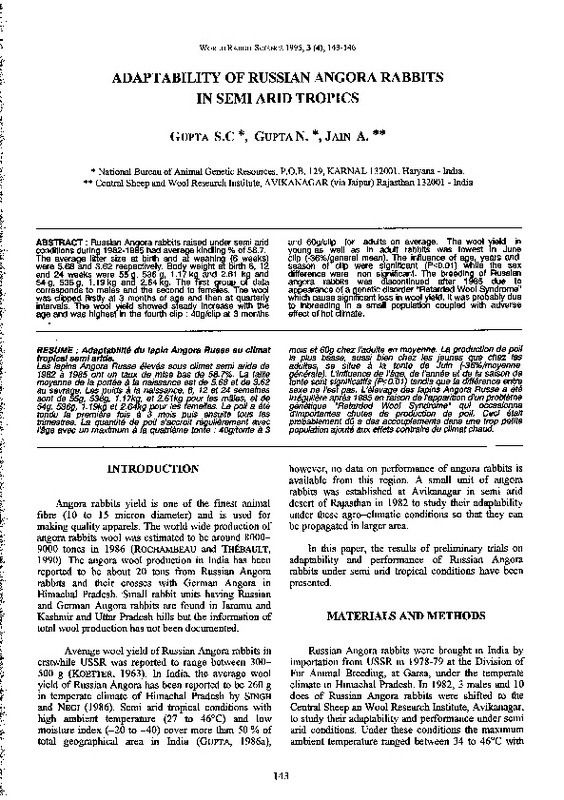JavaScript is disabled for your browser. Some features of this site may not work without it.
Buscar en RiuNet
Listar
Mi cuenta
Estadísticas
Ayuda RiuNet
Admin. UPV
ADAPTABILITY OF RUSSIAN ANGORA RABBITS IN SEMI ARID TROPICS
Mostrar el registro sencillo del ítem
Ficheros en el ítem
| dc.contributor.author | Gupta, S.C.
|
|
| dc.contributor.author | Gupta, N.
|
|
| dc.contributor.author | Jain, A.
|
|
| dc.date.accessioned | 2011-03-21T13:57:51Z | |
| dc.date.available | 2011-03-21T13:57:51Z | |
| dc.date.issued | 1995 | |
| dc.identifier.issn | 1257-5011 | |
| dc.identifier.uri | http://hdl.handle.net/10251/10501 | |
| dc.description.abstract | [EN] Russian Angora rabbits raised under semi arid conditions during 1982-1985 had average kindling % of 58.7. The average litter size at birth and at weaning (6 weeks) were 5.68 and 3.62 respectively. Body weight al birth 6, 12 and 24 weeks were 55 g, 536 g, 1.17 kg and 2.61 kg and 54 g, 536 g, 1.19 kg ana 2.64 l<g. The first grouR of data corresponds to males and the second to feméiles. The wool was clipped firstly at 3 months of age and then at quarterly intervafs. The wool yield showed steady increase with the age and was highest in the fourth clip : 40g/clip at 3 months and 60g/clip for adults on average. The wool yield in young as well as in adult rabbits was lowest in June clip (-36%/general mean}. The influence of age, years and season of clip were s1gnificant (Ps;0.01) while the sex difference were non significant. The breeding of Russian angora rabbits was discontinuad after 1985 due to appearance of a genetic disorder "Retardad Wool Syndrome" which cause signíficant loss in wool yield. lt was probably due to inbreeding in a small population coupled with adversa effect of hot climate. | es_ES |
| dc.description.abstract | [FR] Les lapins Angora Russe élevés sous climat semi aride de 1982 a 1985 ont un taux de mise bas de 58.7%. La taille moyenne de la portée a la naissance est de 5.68 et de 3.62 au sevrage. Les poids a la naissance, 6, 12 et 24 semaines sont de 55g, 536g, 1.17kg, et 2.61kg pour les mb.les, et de 54g, 536g, 1. 19kg et 2.64kg pour les feme/les. Le poi/ a été tondu la premiére fois a 3 mois puis ensuite tous les trimestres. La quantité de poi/ s'accroit régulierement avec /'§ge avec un maximum a la quatrieme tonte : 40g!tonte a 3 mois et 60g chez l'adulte en moyenne. La production de poi/ la plus btisse, aussi bien chez les jeunes que chez les adultes, se situe a la tonte de Juin (-36%/moyenne générale). L'influence de !'§ge, de l'année et de la sa1son de lonte sont significatifs (Ps;O.V1) tandis que la différence entre sexe ne l'esl pas. L'élevage des lapins Angora Russe a été irréguliere apres 1985 en raison de l'apparition d'un probleme génétique ªRetarded Wool Syndrome• qui occasionna a'importantes chutes de production de poi/. Ceci était probablement dó a des accouplements dans une trop petite population ajouté aux effets contraire du climat chaud. | |
| dc.language | Inglés | es_ES |
| dc.publisher | World Rabbit Science. ICTA. UPV | es_ES |
| dc.relation.ispartof | World Rabbit Science | |
| dc.rights | Reserva de todos los derechos | es_ES |
| dc.title | ADAPTABILITY OF RUSSIAN ANGORA RABBITS IN SEMI ARID TROPICS | es_ES |
| dc.type | Artículo | es_ES |
| dc.date.updated | 2011-03-21T13:35:48Z | |
| dc.identifier.doi | 10.4995/wrs.1995.254 | |
| dc.rights.accessRights | Abierto | es_ES |
| dc.description.bibliographicCitation | Gupta, S.; Gupta, N.; Jain, A. (1995). ADAPTABILITY OF RUSSIAN ANGORA RABBITS IN SEMI ARID TROPICS. World Rabbit Science. 3(4). https://doi.org/10.4995/wrs.1995.254 | es_ES |
| dc.description.accrualMethod | SWORD | es_ES |
| dc.relation.publisherversion | https://doi.org/10.4995/wrs.1995.254 | |
| dc.description.volume | 3 | |
| dc.description.issue | 4 | |
| dc.identifier.eissn | 1989-8886 | es_ES |








